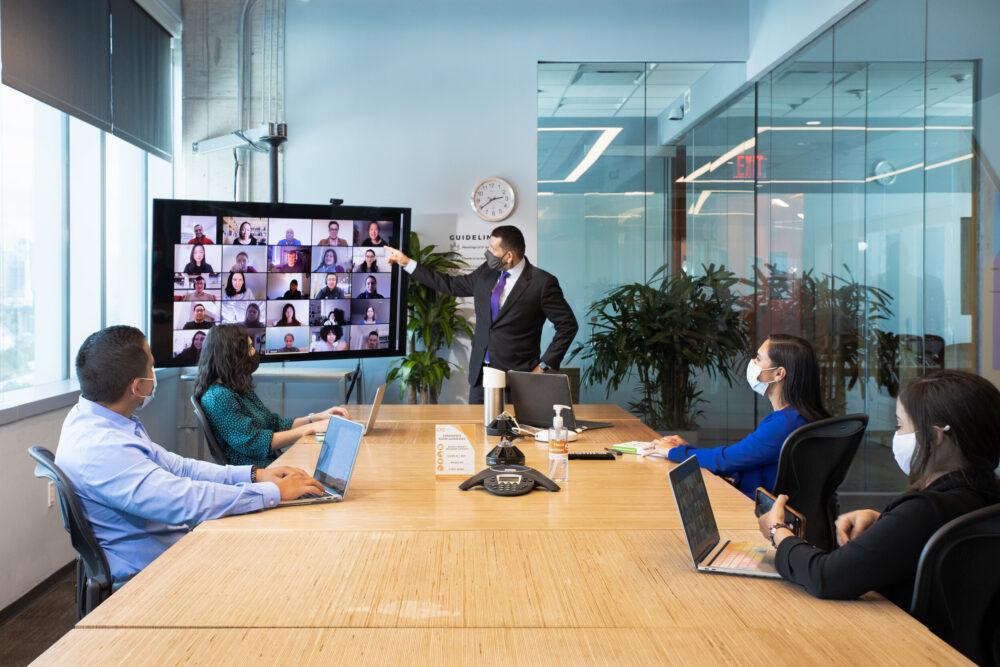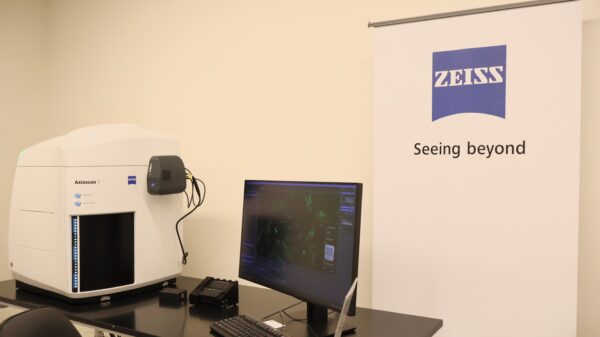Many teams are preparing to transition back to the office, at least part-time. This means more in-person collaboration and communication. But with some teammates still remote or spread out geographically, hybrid in-person/remote meetings are becoming more common, potentially for the long haul.
Every meeting style has its own benefits and its unique challenges. Hybrid meetings are a natural outgrowth of a more flexible work model, but there are some considerations to keep in mind to ensure that these meetings are productive, run smoothly, and encourage effective participation.
Taking the lessons learned from virtual meetings, we’re here to share tips to successfully transition into the hybrid meeting space. With this checklist in hand, you’ll be ready to plan.
1. Establish the priorities of your meeting
Is your priority to have as many people gathered in person as possible? To have an engaged discussion with in-room & remote attendees? To have team members from different sites give presentations or updates? If you can’t have 100% of your ideal outcome, which details are “must haves” to allow the meeting to go forward, and which are “nice to have”?
By solidifying your priorities early on, you’ll be able to plan an effective meeting layout to accomplish your goals. Hybrid meetings can take a lot of forms, and this strategy will help you find the best format, tech, and space to suit the needs of your meeting.
Tip: Not sure where to start in planning your meeting structure? Interaction Associates offers free virtual webinars and long-form paid workshops on how to run better meetings.
2. Identify who will be attending your meeting and how they will participate
Even if just one person remotely dials into the meeting, you’re hosting a hybrid meeting, and you will have different needs than an entirely virtual or entirely in-person meeting. When planning, consider the following questions:
-
Is everyone expected to have their camera on during the meeting?
Tip: Make sure you set expectations prior to the meeting if participants will be asked to be on video.
-
Will you be capturing room video from participants meeting in an in-person space? If so, what two-way video conferencing equipment will you use to support that?
Tip: If you plan to have in-room attendees use their individual laptop cameras, make sure they know to bring their laptops and have a plan for your audio — multiple people playing audio from their personal devices or using multiple mics can lead to echoes if not properly set up. Tell in-room participants to mute their mics and computer audio to prevent this.
-
Is video necessary? If you just need to be heard, you can use a conference phone for in-room participants.
Tip: Some conferencing systems have extension mics you can plug in to support a socially-distanced setup.
3. When planning your format, accommodate remote participants first
Groups meeting in a room together naturally command more attention — it’s easier for in-person participants to bounce ideas off of each other, interrupt, and give non-verbal input. On the other hand, virtual attendees may not be able to participate as easily and might miss out on being able to read body language, raise a hand to interrupt, and so on. To accommodate the imbalance, create a structure that favors virtual participants.
Virtual meetings are typically shorter than in-person ones, and if you’re hosting a hybrid meeting, you’ll want to schedule it to play to the virtual participant (in-person participants likely won’t object to a shorter meeting either!).
This principle also applies to your tech setup. If there will be multiple people participating who are in person together, make sure you’ve identified a solution for remote attendees to hear everyone in-room (e.g. multiple microphones placed throughout the space or seating in-person speakers near each other) and to share their own input.
Tip: If you’re using a video conferencing camera to capture in-room participants, consider camera placement in your setup. If the camera is in the center of a conference room table but in-room participants are looking to the front of the room at a screen, you will be capturing the sides of their faces, which is not a good experience for remote participants.
4. Consider appointing a meeting facilitator
If your meeting is highly participatory, you may want to consider appointing someone to act as a representative for remote attendees and to facilitate meeting flow. This role can also help elicit responses from remote participants; if everyone else is in a room together save for a few remote attendees, they may not feel confident in speaking up and giving input. A meeting facilitator can act as the remote participant representative and create space for everyone to give input.
Tip: Check out our blog post on how to host hybrid events to learn more about how a virtual attendee manager can benefit your team.
5. Choose a broadcasting software
Pick a platform that works well for you. Are you using virtual whiteboards? Launching a poll? Streaming an all-hands meeting with your global team? Make sure that your software choice works to support the priorities you established at the start of your hybrid meeting planning.
Tip: Not sure where to begin? Learn more about different types of events and the best software and broadcasting platforms to support them.
6. Figure out where onsite participants will be broadcasting and use tech that will support your setup
A large meeting room or event space will require different technology to capture the sound and picture in the room than a small conference room will. You may need to pair multiple conferencing systems to make sure everyone is heard, especially if they’re spread throughout the space. Make sure that, when deciding on your tech, you know what kind of physical space you’ll be using.
Tip: Owl Labs and Poly carry conferencing systems that can connect to your device and help facilitate hybrid meetings. You can use multiple paired systems to increase the reach of your audio/video in the room.
7. Test your tech in the space you’ll be using before the meeting starts.
Seems basic, right? But with hybrid meetings, you need to test both the hardware (the technology you’re using to connect, such as a camera, microphone, etc.) and the software (your broadcasting platform, such as Zoom). Often, individual software programs will have their own settings for input/output, so you may need to change some settings in the software itself to get the tech setup that works for you. And testing out the tech in your broadcasting space is ideal — you may discover details about the room you’re in that impact the setup or tech you choose.
Tip: Avoid common tech pitfalls with this blog post!
8. Follow the meeting with a recap
Even with the best tech setups, collaborating across sites and laptops can be tricky. This has always been true, but it’s especially pronounced in a hybrid meeting setting, where people may be multitasking with emails and site-specific distractions. Have someone take notes during the meeting and send out action items following the meeting.
Some video conferencing software, such as Zoom, will also allow you to record for any participants who weren’t able to make the live meeting or in case you need to revisit talking points.
Tip: If you’re collaborating on a project, apps such as Asana can be great for managing both action items and meeting minutes, and are easy to facilitate remotely.
9. When in doubt, ask the experts
There are different logistic details involved in hosting hybrid meetings. Talk to the venue manager about what technology they have available, setups they’ve seen work well, and how to set yourself up for success in managing your hybrid meeting.
Tip: Every CIC location has resources and staff available to help our members with their hybrid meetings. If you work out of a CIC space, talk to your local community or event team to learn more!
Getting ready to host hybrid meetings
Meetings with both in-person and remote participants require a bit more forethought, but they can be a valuable tool in today’s workplace. Getting accustomed to the details above will help you run those hybrid meetings productively and seamlessly.
Looking for workspace that can support hybrid meetings? CIC memberships give you unlimited access to conference rooms with video conferencing technologies and onsite support staff to make your work easier. Take a peek at our spaces by booking a free virtual or in-person tour:




